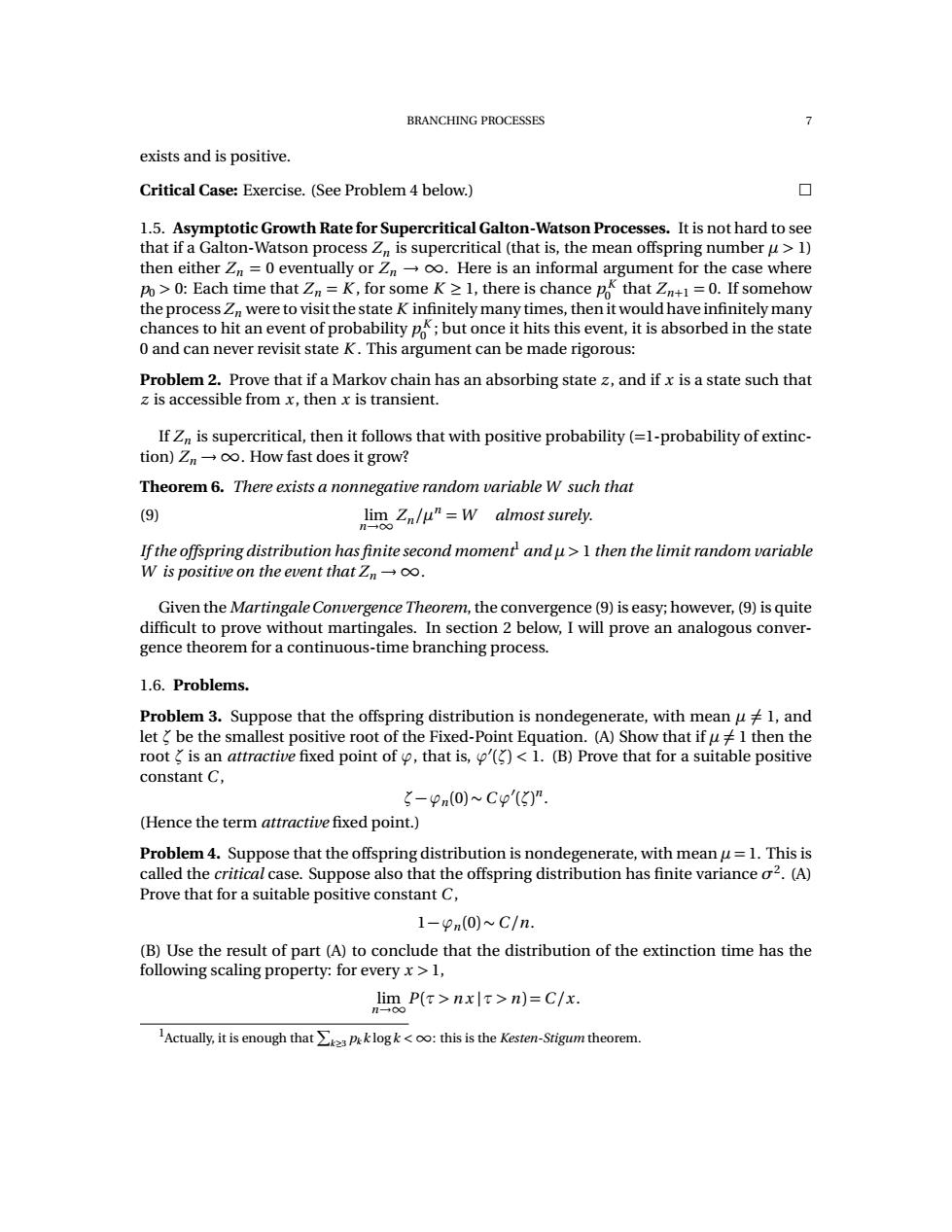正在加载图片...

BRANCHING PROCESSES exists and is positive. Critical Case:Exercise.(See Problem 4 below.) 0 1.5.Asymptotic Growth Rate for Supercritical Galton-Watson Processes.It is not hard to see that if a Galton-Watson process Zn is supercritical(that is,the mean offspring number u>1) then either Zn=0 eventually or Znoo.Here is an informal argument for the case where po >0:Each time that Zn=K,for some K >1,there is chance po that Zn+1=0.If somehow the process Zn were to visit the state K infinitely many times,then it would have infinitely many chances to hit an event of probability p;but once it hits this event,it is absorbed in the state 0 and can never revisit state K.This argument can be made rigorous: Problem 2.Prove that if a Markov chain has an absorbing state z,and if x is a state such that z is accessible from x,then x is transient. If Zn is supercritical,then it follows that with positive probability(=1-probability of extinc- tion)Zno.How fast does it grow? Theorem 6.There exists a nonnegative random variable W such that (9) i。Zn/μ"=W almost surely. If the offspring distribution has finite second moment andu>1 then the limit random variable W is positive on the event that Zn-. Given the Martingale Convergence Theorem,the convergence(9)is easy;however,(9)is quite difficult to prove without martingales.In section 2 below,I will prove an analogous conver- gence theorem for a continuous-time branching process. 1.6.Problems. Problem 3.Suppose that the offspring distribution is nondegenerate,with mean u1,and let be the smallest positive root of the Fixed-Point Equation.(A)Show that ifu 1 then the root is an attractive fixed point of that is,()<1.(B)Prove that for a suitable positive constant C, g-pn(0)~Cp'(g). (Hence the term attractive fixed point.) Problem 4.Suppose that the offspring distribution is nondegenerate,with mean u=1.This is called the critical case.Suppose also that the offspring distribution has finite variance o2.(A) Prove that for a suitable positive constant C, 1-pn(0)~C/n. (B)Use the result of part(A)to conclude that the distribution of the extinction time has the following scaling property:for every x>1, lim P(t>nxlt>n)=C/x. 11+●● lActually,it is enough thatklogk<o:this is the Kesten-Stigum theorem.BRANCHING PROCESSES 7 exists and is positive. Critical Case: Exercise. (See Problem 4 below.) 1.5. Asymptotic Growth Rate for Supercritical Galton-Watson Processes. It is not hard to see that if a Galton-Watson process Zn is supercritical (that is, the mean offspring number µ > 1) then either Zn = 0 eventually or Zn → ∞. Here is an informal argument for the case where p0 > 0: Each time that Zn = K , for some K ≥ 1, there is chance p K 0 that Zn+1 = 0. If somehow the process Zn were to visit the state K infinitely many times, then it would have infinitely many chances to hit an event of probability p K 0 ; but once it hits this event, it is absorbed in the state 0 and can never revisit state K . This argument can be made rigorous: Problem 2. Prove that if a Markov chain has an absorbing state z , and if x is a state such that z is accessible from x , then x is transient. If Zn is supercritical, then it follows that with positive probability (=1-probability of extinction) Zn →∞. How fast does it grow? Theorem 6. There exists a nonnegative random variable W such that (9) limn→∞ Zn /µn = W almost surely. If the offspring distribution has finite second moment1 and µ > 1 then the limit random variable W is positive on the event that Zn →∞. Given the Martingale Convergence Theorem, the convergence (9) is easy; however, (9) is quite difficult to prove without martingales. In section 2 below, I will prove an analogous convergence theorem for a continuous-time branching process. 1.6. Problems. Problem 3. Suppose that the offspring distribution is nondegenerate, with mean µ 6= 1, and let ζ be the smallest positive root of the Fixed-Point Equation. (A) Show that if µ 6= 1 then the root ζ is an attractive fixed point of ϕ, that is, ϕ 0 (ζ) < 1. (B) Prove that for a suitable positive constant C , ζ − ϕn (0) ∼ C ϕ 0 (ζ) n . (Hence the term attractive fixed point.) Problem 4. Suppose that the offspring distribution is nondegenerate, with mean µ = 1. This is called the critical case. Suppose also that the offspring distribution has finite variance σ2 . (A) Prove that for a suitable positive constant C , 1 − ϕn (0) ∼ C /n. (B) Use the result of part (A) to conclude that the distribution of the extinction time has the following scaling property: for every x > 1, limn→∞ P (τ > n x |τ > n) = C /x . 1Actually, it is enough that P k≥3 pk k logk <∞: this is the Kesten-Stigum theorem.�